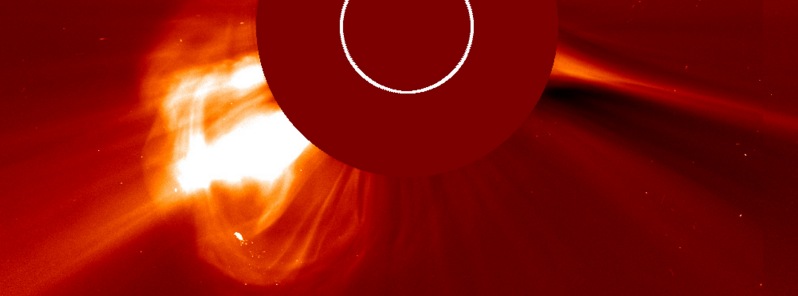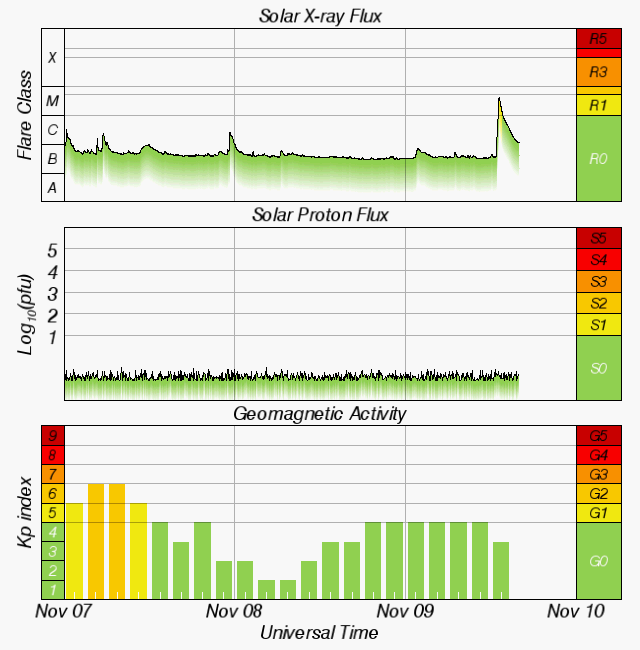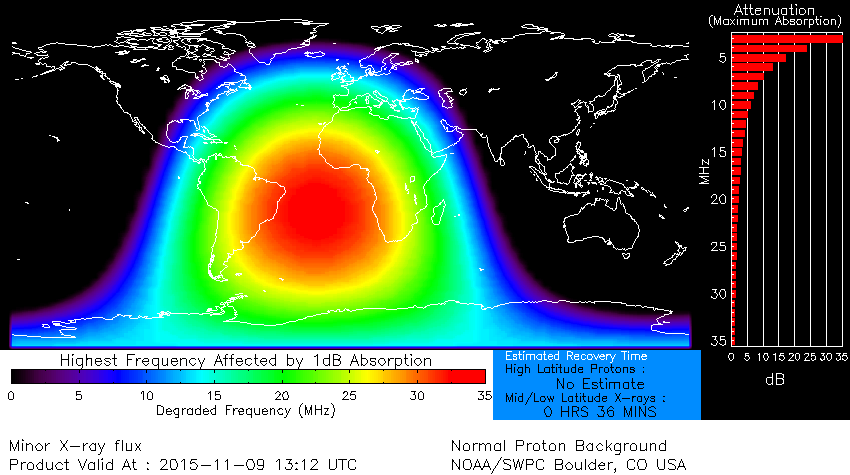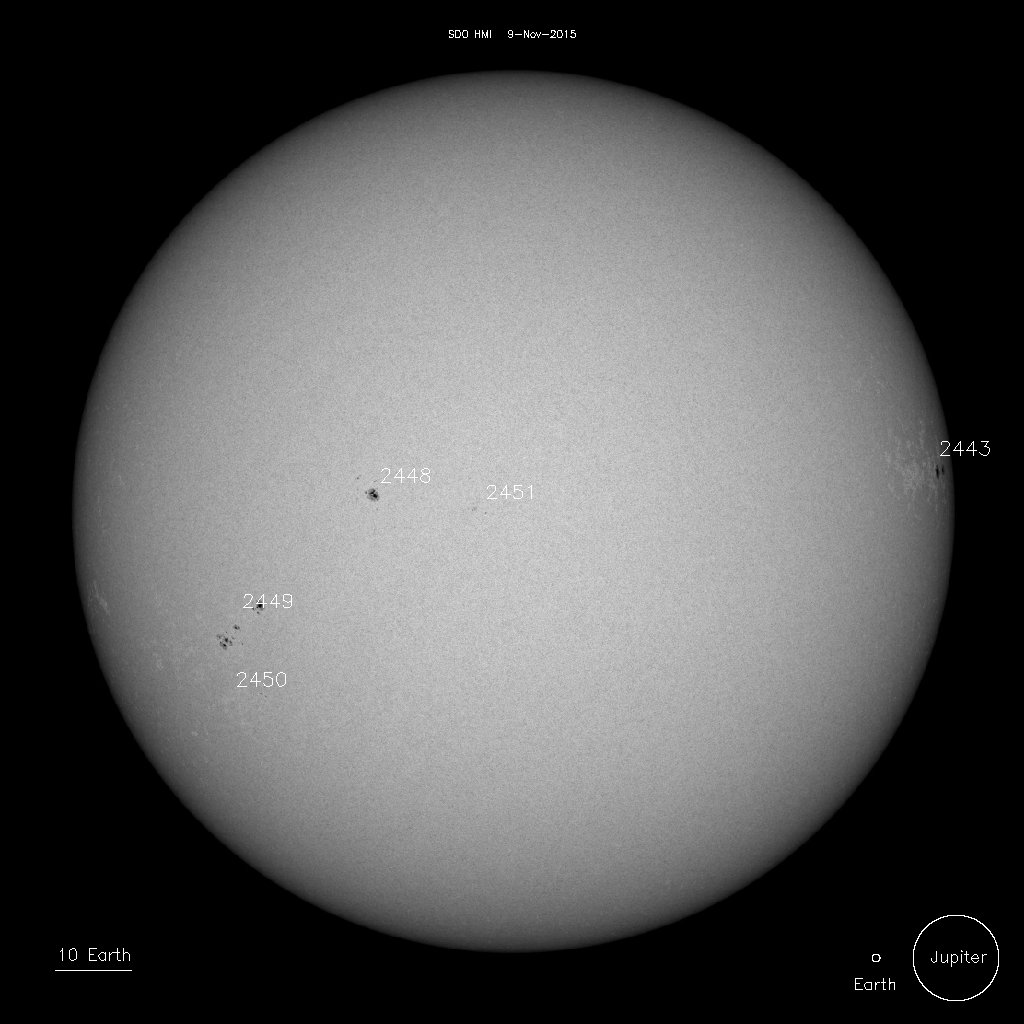Strong M3.9 solar flare erupts from Region 2449 producing a bright CME

A strong solar flare measuring M3.9 at its peak erupted from Region 2449 at 13:12 UTC on November 9, 2015. The event started at 12:49 and ended at 13:28 UTC. A bright Coronal Mass Ejection (CME) was produced.
The event was associated with a Type II (estimated velocity 957 km/s) and a Type IV radio emissions. Type IV emissions occur in association with major eruptions on the Sun and are typically associated with strong CMEs and solar radiation storms.
Additionally, a 10cm Radio Burst lasting 11 minutes (peak flux 670 sfu), was associated with the flare event. This can be indicative of significant radio noise in association with a solar flare. This noise is generally short-lived but can cause interference for sensitive receivers including radar, GPS, and satellite communications.
Region 2449 has 'Beta' magnetic configuration and is now rotating into a more geoeffective position, showing signs of a minor growth.
CME produced by today's M3.9 solar flare is not Earth-directed, however, a glancing blow is possible in about 2 – 3 days.


Image credit: ESA/NASA SOHO LASCO C2

D-RAP at M3.9 solar flare's peak. Image credit: NOAA/SWPC.
SWPC reports a filament eruption centered near N05E51 was observed lifting off in GONG/H-Alpha imagery between 00:25-02:40 UTC on November 9. Further analysis will be conducted to determine if there is a CME associated with this event as more coronagraph imagery becomes available.
Solar activity is expected to be low with a slight chance for M-class (R1-R2 (Minor-Moderate) Radio Blackouts) flares over the next three days (November 09 – 11).
Sunspots
There are currently 5 numbered sunspot regions on the Earth side of the Sun.
Region 2449 showed minor growth over the last 24 hours while the remaining active regions were either stable or in decay.

Sunspots on November 9, 2015. Image credit: NASA/SDO HMI
2443 – Beta
2448 – Beta
2449 – Beta
2450 – Beta
2451 – Alpha
Energetic particle
The greater than 2 MeV electron flux reached high levels with a peak flux of 6,280 pfu observed at 11:55 UTC today. The greater than 10 MeV proton flux was at background levels throughout the period.
The greater than 2 MeV electron flux is expected to be at moderate to high levels over the next three days. The greater than 10 MeV proton flux is expected to persist at background levels throughout the forecast period.
Solar wind
Solar wind parameters indicated the likely onset of a co-rotating interaction region (CIR) associated with a recurrent positive polarity coronal hole. Solar wind speeds were steady between 450 – 500 km/s over the last 24 hours, SWPC said at 12:30 UTC today.
IMF total field strength values decreased from initial values near 10 nT to around 5 nT late in the period while Bz was primarily southward and steady near -4 nT. The phi angle was steady in a positive (away from the Sun) solar sector orientation until around 17:00 UTC on November 8 when it became variable.
Solar wind speeds are expected to remain slightly enhanced (~450-550 km/s) over the next three days due to continued CH HSS influence.
Geospace
The geomagnetic field was at quiet to active levels over the last 24 hours. It is expected to reach G1 (Minor) geomagnetic storm levels mid-day to late on November 9 due to CIR effects followed by the influence of a positive polarity CH HSS. Quiet to active field conditions are expected on November 10 to 11 due to continued but weakening CH HSS influence.
SWPC alerts for M3.9 solar flare
Space Weather Message Code: SUM10R
Serial Number: 677
Issue Time: 2015 Nov 09 1341 UTC
SUMMARY: 10cm Radio Burst
Begin Time: 2015 Nov 09 1300 UTC
Maximum Time: 2015 Nov 09 1306 UTC
End Time: 2015 Nov 09 1311 UTC
Duration: 11 minutes
Peak Flux: 670 sfu
Latest Penticton Noon Flux: 108 sfu
NOAA Space Weather Scale descriptions can be found at
www.swpc.noaa.gov/noaa-scales-explanation
Description: A 10cm radio burst indicates that the electromagnetic burst associated with a solar flare at the 10cm wavelength was double or greater than the initial 10cm radio background. This can be indicative of significant radio noise in association with a solar flare. This noise is generally short-lived but can cause interference for sensitive receivers including radar, GPS, and satellite communications.
***
Space Weather Message Code: ALTTP2
Serial Number: 1032
Issue Time: 2015 Nov 09 1338 UTC
ALERT: Type II Radio Emission
Begin Time: 2015 Nov 09 1305 UTC
Estimated Velocity: 957 km/s
NOAA Space Weather Scale descriptions can be found at
www.swpc.noaa.gov/noaa-scales-explanation
Description: Type II emissions occur in association with eruptions on the sun and typically indicate a coronal mass ejection is associated with a flare event.
***
Space Weather Message Code: ALTTP4
Serial Number: 519
Issue Time: 2015 Nov 09 1324 UTC
ALERT: Type IV Radio Emission
Begin Time: 2015 Nov 09 1305 UTC
NOAA Space Weather Scale descriptions can be found at
www.swpc.noaa.gov/noaa-scales-explanation
Description: Type IV emissions occur in association with major eruptions on the sun and are typically associated with strong coronal mass ejections and solar radiation storms.
Featured image credit: Coronal Mass Ejection produced by the M3.9 solar flare on November 9, 2015. Credit: ESA/NASA SOHO LASCO C2

Commenting rules and guidelines
We value the thoughts and opinions of our readers and welcome healthy discussions on our website. In order to maintain a respectful and positive community, we ask that all commenters follow these rules:
We reserve the right to remove any comments that violate these rules. By commenting on our website, you agree to abide by these guidelines. Thank you for helping to create a positive and welcoming environment for all.